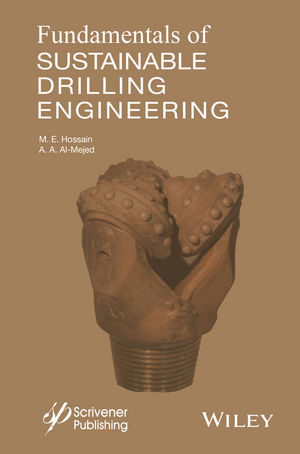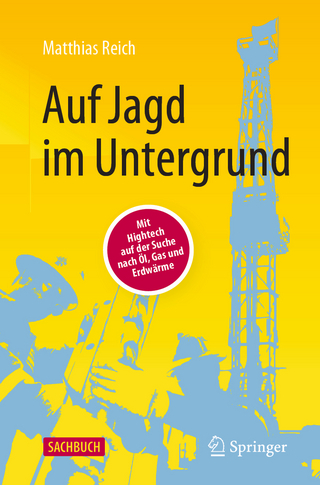
Fundamentals of Sustainable Drilling Engineering
Wiley-Scrivener (Verlag)
978-0-470-87817-0 (ISBN)
M.E. Hossain, PhD, is an assistant professor in the department of petroleum engineering at King Fahd University of Petroleum & Minerals. He earned his PhD in petroleum engineering from Dalhousie University in 2008 and is the author of one book and over 40 research on petroleum engineering. A. Al-Majed, PhD, is an associate professor in the department of petroleum engineering at King Fahd University of Petroleum & Minerals, earning his PhD in petroleum engineering in 1988 from the University of Southern California. Dr Al-Majed's industrial experience includes working in the reservoir, production, drilling and workover departments, including over twenty years of experience in teaching drilling engineering.
Foreword xix
Preface xxi
Acknowledgements xxiii
Summary xxv
1 Introduction 1
1.1 Introduction 1
1.2 Introduction of Drilling Engineering 1
1.3 Importance of Drilling Engineering 2
1.4 Application of Drilling Engineering 2
1.5 History of Oil Discovery 3
1.6 An Overview of Drilling Engineering 5
1.7 Organization Chart and Manpower Requirements during Drilling Operations 12
1.8 Aspect of Sustainability in Drilling Operations 13
1.9 Summary 15
References 16
2 Drilling Methods 17
2.1 Introduction 17
2.2 Types of Drilling Methods 18
2.3 Rotary Drilling Rig and its Components 20
2.4 Drilling Process 22
2.5 Types of Rotary Drilling Rigs 50
2.6 Nature and Need for Sustainable Drilling Operations 57
2.7 Current Practice in the Industries 58
2.8 Future Trend in Drilling Methods 61
2.9 Summary 62
2.10 Nomenclature 62
2.11 Exercise 63
Appendix 2A 65
Rig Floor (Conventional Rotary Rig) 65
Rig Floor (Top Drive) 65
Blowout Preventer Stack And Wellhead 66
Drilling Fluid Equipment 66
References 71
3 Drilling Fluids 73
3.1 Introduction 73
3.2 Drilling Fluid Circulating System 74
3.3 Classifi cation of Drilling Fluids 76
3.4 Composition of Drilling Fluids 82
3.5 Mud Additives 84
3.6 Measurement of Drilling Fluids Properties 101
3.7 New Drilling Mud Calculations 124
3.8 Design of Mud Weight 125
3.9 Current Developments in Drilling Fluids 128
3.10 Future Trend on Drilling Fluids 131
3.11 Summary 133
3.12 Nomenclature 133
3.13 Exercises 135
References 136
4 Drilling Hydraulics 141
4.1 Introduction 141
4.2 Types of Fluids 142
4.3 Flow Regimes 156
4.4 Hydrostatic Pressure Calculation 162
4.5 Fluid Flow through Pipes 169
4.6 Fluid Flow through Drill Bits 171
4.7 Pressure Loss Calculation of the Rig System 173
4.8 Current Development on Drilling Hydraulics 183
4.9 Future Trend on Drilling Hydraulics 192
4.10 Summary 195
4.11 Nomenclature 195
4.12 Exercise 197
References 199
5 Well Control and Monitoring Program 205
5.1 Introduction 205
5.2 Well Control System 206
5.3 Warning Signals of Kicks 211
5.4 Control of Infl ux and Kill Mud 214
5.5 BOP Equipment for Well Control System 227
5.6 Well Monitoring System 238
5.7 Current Practice in Well Control and Monitoring 240
5.8 Future Trend on Well Control and Monitoring System 244
5.9 Summary 247
5.10 Nomenclature 247
5.11 Exercise 248
References 249
6 Formation Pore and Fracture Pressure Estimation 251
6.1 Introduction 251
6.2 Geological Aspects of Rock Mechanics in Drilling 252
6.3 Current Development on Formation Pore and Fracture Pressure 312
6.4 Future Trend on Formation Pore and Fracture Pressure 313
6.5 Summary 314
6.6 Nomenclature 314
6.7 Exercise 317
References 318
7 Basics of Drill String Design 321
7.1 Introduction 321
7.2 Drill String Components 322
7.3 Drilling Bit 334
7.4 Drill String Design 344
7.5 Bit Design 364
7.6 Drilling Bit Selection 366
7.7 Drilling Bit Performance 368
7.8 Drilling Optimization Techniques 371
7.9 Factors Aff ecting Rate of Penetration 379
7.10 Rate of Penetration Modelling 392
7.11 Current Development on Drill String and Bottomhole Assembly Design 416
7.12 Future Trend on Drill String and Bottomhole Assembly Design 423
7.13 Summary 424
7.14 Nomenclature 424
7.15 Exercise 427
References 428
8 Casing Design 433
8.1 Introduction 433
8.2 Importance of Casing String 434
8.3 Types of Casing String 435
8.4 Components of Casing String 441
8.5 Classifi cation and Properties of Casing 442
8.6 Manufacturing of Casing 446
8.7 Rig-site Operation 447
8.8 Casing Design and Selection Criteria 451
8.9 Current Development in Casing Technology 477
8.10 Discussions on Some Case Studies 490
8.11 Future Trend on Casing Design Development 497
8.12 Summary 498
8.13 Nomenclature 498
8.14 Exercises 499
References 500
9 Cementing 503
9.1 Introduction 503
9.2 Applications of Oil Well Cements 504
9.3 Cement Production 508
9.4 Classifications of Oil Well Cements 510
9.5 Cement Properties 513
9.6 Types of Cementing 522
9.7 Oil Well Cement Additives 528
9.8 Cementing Design Process 531
9.9 Laboratory Tests on Cements Slurry 534
9.10 Mechanics of Cementing 549
9.11 Cement Job Evaluation 555
9.12 Cement Volume Calculation 557
9.13 Practical Calculations 558
9.14 Recommendations for Successful Cementing 564
9.15 Current Development on Cementing 564
9.16 Future Trend on Cementing 565
9.17 Summary 566
9.18 Nomenclature 567
9.19 Exercises 568
References 570
10 Horizontal and Directional Drilling 571
10.1 Introduction 571
10.2 Functions 572
10.3 Basic Terminologies 576
10.4 Types of Directional Drilling 580
10.5 Well Planning Trajectory 594
10.6 Directional Drilling Tools 599
10.7 Well Survey 616
10.8 Geo-steering 635
10.9 Current Trends in Directional Drilling 636
10.10 Future Trends in Directional Drilling 637
10.11 Summary 639
10.12 Nomenclature 639
10.13 Exercise 640
References 642
11 Well Drilling Cost Analysis 643
11.1 Introduction 643
11.2 Variables Related to Drilling Costs 644
11.3 Types of Well Drilling Costs 645
11.4 Brake Down of Total Well Drilling Cost 647
11.5 Authorisation for Expenditure 647
11.6 Drilling Cost Estimation 649
11.7 Well Drilling Time Estimation 656
11.8 Time Value of Investment 668
11.9 Price Elasticity 669
11.10 Current Trend on Drilling Cost Analysis 670
11.11 Future Trend on Drilling Cost Analysis 672
11.12 Summary 673
11.13 Nomenclature 673
11.14 Exercise 674
References 677
12 Well Completion 679
12.1 Introduction 679
12.2 History of Well Completion 680
12.3 Requirements for Well Completion 680
12.4 Types of Well Completion 683
12.5 Factors Infl uencing Well Completion Design 695
12.6 Completion Equipment and Materials 697
12.7 Sand Control 719
12.8 Remedial Cementing 721
12.9 Corrosion and Corrosion Prevention 724
12.10 Current Development on Well Completion 729
12.11 Future Trend on Well Completion 733
12.12 Summary 735
References 735
Index 737
| Reihe/Serie | Wiley-Scrivener |
|---|---|
| Sprache | englisch |
| Maße | 185 x 262 mm |
| Gewicht | 1765 g |
| Themenwelt | Geisteswissenschaften ► Geschichte |
| Naturwissenschaften ► Chemie | |
| Naturwissenschaften ► Geowissenschaften ► Geologie | |
| Technik ► Bergbau | |
| Technik ► Elektrotechnik / Energietechnik | |
| ISBN-10 | 0-470-87817-7 / 0470878177 |
| ISBN-13 | 978-0-470-87817-0 / 9780470878170 |
| Zustand | Neuware |
| Informationen gemäß Produktsicherheitsverordnung (GPSR) | |
| Haben Sie eine Frage zum Produkt? |
aus dem Bereich


